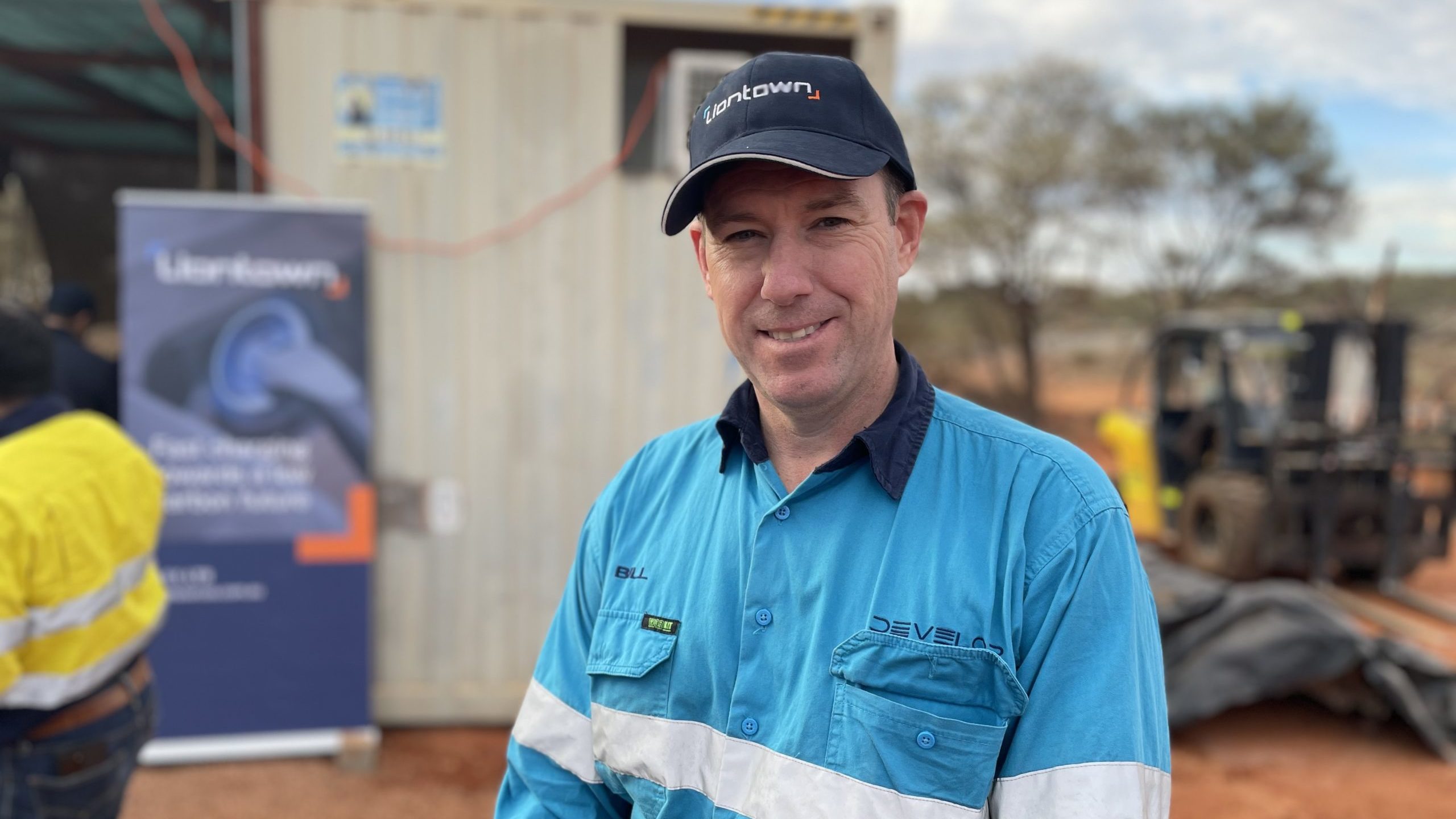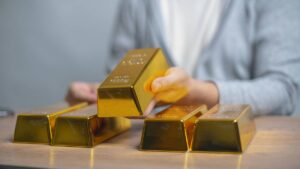Battery metals are all the rage, but can old world gold miners be green investments too?

Bill Beament says his mining services firm Develop will help miners hit ESG commitments by utilising expertise in underground mining. Pic: Josh Chiat/Stockhead
- Gold miner Bellevue Gold says ESG and carbon emissions will be one of the key investment metrics for gold miners in the market of the future
- Liontown Resources says it is focused on building a world-first underground lithium mine with ironclad ESG and renewable credentials
- Experts say miners need to walk the walk not just talk the talk on ESG
‘Gold is not green’
That was the shocking phrase Bill Beament, who rose to prominence in the Australian mining industry as the head of ASX100 gold miner Northern Star Resources (ASX:NST), rolled out as he launched battery metals focused mining contractor Develop (ASX:DVP) in his old home of Kalgoorlie last year.
Some surprise then that this year he returns to its world famous mining forum Diggers and Dealers with his first contract a high profile win at Bellevue Gold’s (ASX:BGL) new 200,000ozpa gold mine in WA’s northern Goldfields.
The attraction is partly Bellevue’s promise of producing gold at one of the lowest carbon intensities in the world, a function of Bellevue’s high grade and simple geology.
“From a mine ownership perspective I’ve always said I’m only going to be involved in clean, future facing metals, but mining services I’ve said I’d always work with the industry on that but only if I can help them with their ESG promises,” he told Stockhead.
“I was very up front with that and Bellevue is going to produce at one of the lowest carbon intensities in the Australian gold industry if not the world.
“It ticks the box, if we can do that more efficiently and lower their unit costs and Scope 1 and Scope 2 (emissions), it’s a good proposition for everyone.
“Make no mistake we have to dig this stuff up for the world’s industrial needs and we are going to need gold in the future, but we can do things differently like Bellevue have given us the licence to do.”
It has lost favour in recent times compared to battery metals and so-called ‘future facing commodities’, but can gold be a green investment too?
Greener gold
Located in a rich mining belt surrounded by millions of ounces in gold, not to mention a bounty of nickel and lithium, Bellevue is a curious story.
The mine was abandoned by Plutonic Resources after producing 800,000oz at an incredibly high 15g/t before being shut in 1997 when old timers thought a major fault had ended its golden shears.
In fact, those shears ran in rich veins of golden ore on the other side.
Bellevue, a penny stock when it engineered a reverse takeover of Draig Resources in 2016, is now an $800 million emerging gold miner.
The ~$270 million mine is expected to produce its first gold in the second half of 2023.
Within a resource of 3.1Moz at an impressive 9.9g/t is a shallow reserve of 1.3Moz at 6.1g/t. With inferred resources to be converted to indicated ounces and reserves, 1.8Moz is in the mine plan for its first 10 years, with exploration likely to extend that much further.
Corporate sustainability head Luke Gleeson says it will be some of the cleanest in the industry, with a mix of solar, wind and support from gas generation from a soon to be announced power purchase agreement giving it a renewable mix of up to 80% on opening.
The development would give Bellevue one of the highest penetrations of renewables of any off-grid industrial project in the world.
“We’re looking at anywhere between 0.12-0.2t of carbon an ounce,” Gleeson said.
“The sector’s running at about 0.79t/oz of carbon at the moment, so we’ll be in the bottom quartile on carbon intensity and emissions intensity.”
Not all that glitters
Bellevue has made other ESG moves of late.
It appears to be closing on an agreement with the Tjiwarl traditional owners, having previously abandoned plans to drill at a cultural site on Lake Miranda despite having the same Section 18 consent Rio Tinto (ASX:RIO) held when it legally, but dubiously blasted 40,000 year old rock caves at Juukan Gorge.
It is taking an approach to crafting a native title agreement similar to that inked by nearby lithium developer Liontown Resources (ASX:LTR) with the Tjiwarl a few months ago.
With major funds like BlackRock (~17%) on the top of Bellevue’s register, Gleeson thinks this approach to carbon emissions and social responsibility is crucial to appeal to large institutional investors.
“You only need to look as far as guys like Larry Fink and Evy Hambro, who runs the gold fund at BlackRock, they’re right behind the vision of what we’re looking at doing,” Gleeson said.
“One of the things you’ve always seen in mining is a cost curve, the other thing you’ll see more of is a carbon curve.
“What I mean by that is the world doesn’t want every last tonne of nickel, copper or lithium if it’s up that intensity curve.”
While gold is best known for its use as a safe haven investment and store of value, ESG conscious technology producers are also reliant on supplies of the commodity.
“Gold is used in the electronic market for example, so I certainly think from a green perspective and future facing metals gold does play a part, and that carbon curve you’ll see companies place more focus,” Gleeson said.
“You’ve seen Tom Palmer who runs one of the largest (gold) mining companies in Newmont mentioning that ESG is going to change the investor landscape in gold and he’s 100% right, so we’re positioning Bellevue to be insulated from that effect.
“Potentially we’ll have the ability to be able to sell a product that could effectively trade at a premium.”
Develop (ASX:DVP), Bellevue Gold (ASX:BGL) and Liontown Resources (ASX:LTR) share prices today:
Waste so good it’s better than gold
One aspect of Bellevue its owner says will help reduce its carbon intensity is its geology.
That not only pertains to its high grade, but also its world class ground stability and the predictable and distinct separation between economic ore and waste rock.
Senior geologist Jacqui Rush says while it sounds strange, Bellevue’s waste rock is more exciting than its high grade gold veins.
“The entire workforce can get around knowing what to look for,” she said.
“We’re really lucky this orebody we’re finding is quite predictable.”
That predictability and distinction between waste and ore is beyond evident in the first ore face blasted last week after more than two years of mine development.
Chief geologist Sam Brooks said grade, underground mining methods and the company’s commitment to early uptake of renewables played a part.
“The advantage here is because it’s high grade, we’re underground mining, so we’re not moving large amounts of waste, the tonnage movements for the mine are really low and we can power most of the infrastructure from renewable energy,” he said.
“Just by its very nature the selectivity of the underground mining and selectivity of the orebody means you’re really focused on the ore, not moving a lot of waste and it flows right through to your crushing circuit and processing.
“You’re processing less tonnes so less carbon.”
All the gold, he says, is hosted in a small volume of rock, making a positive impact on reducing tonnage movement.
“It’s all hosted in a very competent basalt unit with very discrete shear zones running through that,” he said.
“When you go from unmineralised basalt into ore it’s a very discrete boundary.”
The high grade and low dilution will help Bellevue get the most out of the mine and its 1.2Mtpa mill, with margins 54% higher than the average of its peers if all goes to plan.
Next cab off the rank
Beament yesterday made no secret of his desire to secure the mining contract at Liontown’s Kathleen Valley.
Just 10km from Bellevue, Liontown is treading a similar path, planning to supply 60% of its initial power needs from wind and solar.
The $545 million lithium mine will be the first in the world to mine underground, leveraging a flat-lying pegmatite that currently extends to around 500m below surface.
Backed by offtake deals with auto and battery majors in Tesla, LG and Ford, including a $300 million funding package from the latter, the mine is under pressure to be delivered with the highest ESG standards when it delivers first spodumene concentrate in Q2 2024.
Liontown ESG manager Clair Wilson said the company is completing a self-assessment to get accredited by the Initiative for Responsible Mining Assurance, one of the highest standards of independent ESG accountability.
“We have agreed and we are going to be accredited, that is our intent, Ford are very excited about that… I think it’s basically going to change the way mining in Australia is going to be done in the future,” she said.
Beament says “he’s out of gold” but that the lower carbon intensity of underground mining and the deeper nature of modern discoveries means it will be the way of the future for ESG friendly gold, base metals and lithium.
“We need to dig stuff up in the future, we need these commodities, and a lot of it is going to be underground,” he said.
“There’s potential Liontown will be the first underground lithium mine.
“People forget the lowest cost mine over 500,000oz in the gold industry is actually an underground mine, it’s Cadia, so you can actually mine really efficiently from underground and disturb less footprint and all that stuff that goes with it.
“A lot of these things like nickel, copper, cobalt and zinc, the backbone of electrification, they produce some nasty outcomes but if you’re doing it from underground you’re producing far less of that material so underground’s going to get very sexy moving forward.”
Look out for real ESG outcomes
So how should investors take claims about ESG, carbon emissions and social responsibility from companies?
Rusty Delroy, the managing director of WA based Nero Resources Fund, says to look for companies that are actually “walking the walk”.
“Currently there aren’t very good standardised measures on these aspects so it’s really important to do the work looking at companies bottom up,” he said.
“We look at what we call ‘real world ESG’. Is the company really walking the walk and that means is the culture from the top down truly dedicated to doing things well?
“If you look at what Bill Beament is doing with Develop and his whole ethos around underground mining and minimising all sorts of real world mining impacts including, but also way beyond, carbon emissions, then you get a sense of where the standard should be.
“Unfortunately there are a few companies out there that make publicity efforts with terms like ‘future industries’ when in reality their existing efforts are exceptionally poor.”
Whether gold fits as an ESG investment, Delroy says it all depends on the environmental standards of the miner, not the commodity the company is producing.
“Absolutely you can be a green gold miner, it’s no different to any other commodity,” he said.
“I think the green movement generally overreaches in trying to dictate what should and shouldn’t be produced.
“In reality the global marketplace will tell you what is needed to be produced – what we need to focus on is how to produce those materials at a really high environmental standard.
“It can be done – it’s just a function of a bit more cost and a heap more thought.”
Delroy says Nero is generally long on energy commodities at the moment.
“Some battery metals such as lithium have clear appeal but we are value guys and trying to find value in the equities there can be hard at times (LPI (ASX:LPI) is a standout in the sector in our view).
“Nickel is now deemed a battery metal but we aren’t sure there are many supply constraints so it’s interesting how the market is valuing stocks quite highly in this space.
“Gold we are very comfortable on the basis that we expect inflation will exceed the cost of capital for a good deal of time and as such erode purchasing power of fiat currency.”
The journalist travelled to Diggers and Dealers as a guest of Bellevue Gold and Liontown Resources.
Related Topics

UNLOCK INSIGHTS
Discover the untold stories of emerging ASX stocks.
Daily news and expert analysis, it's free to subscribe.
By proceeding, you confirm you understand that we handle personal information in accordance with our Privacy Policy.








